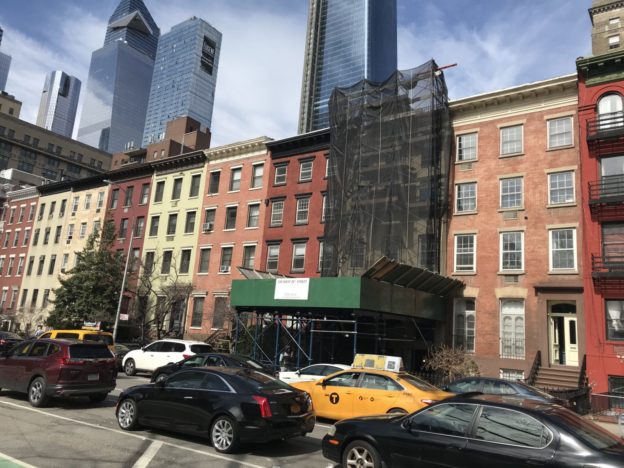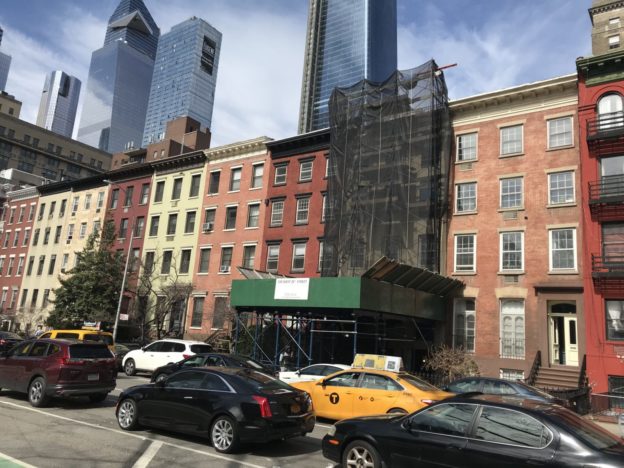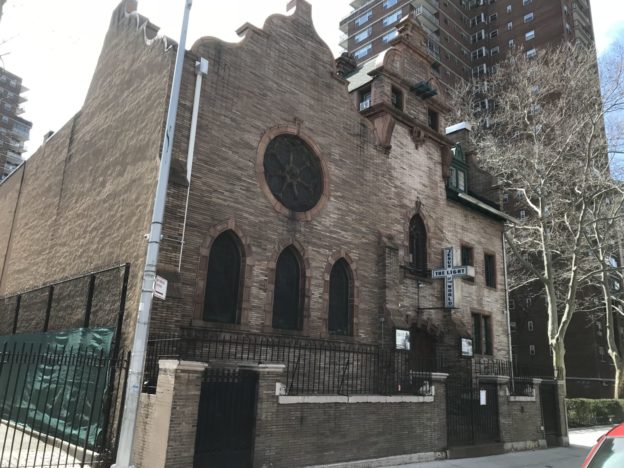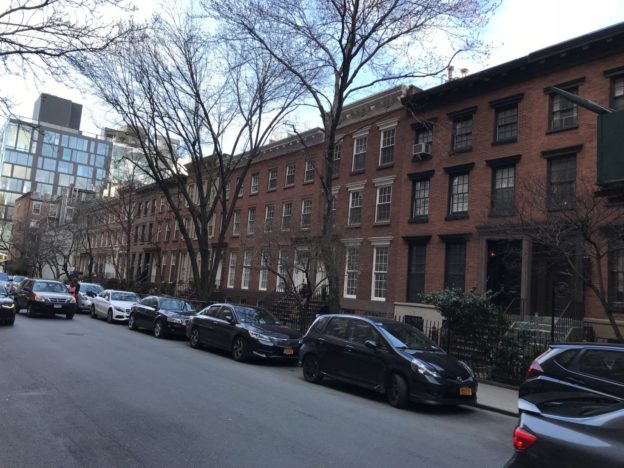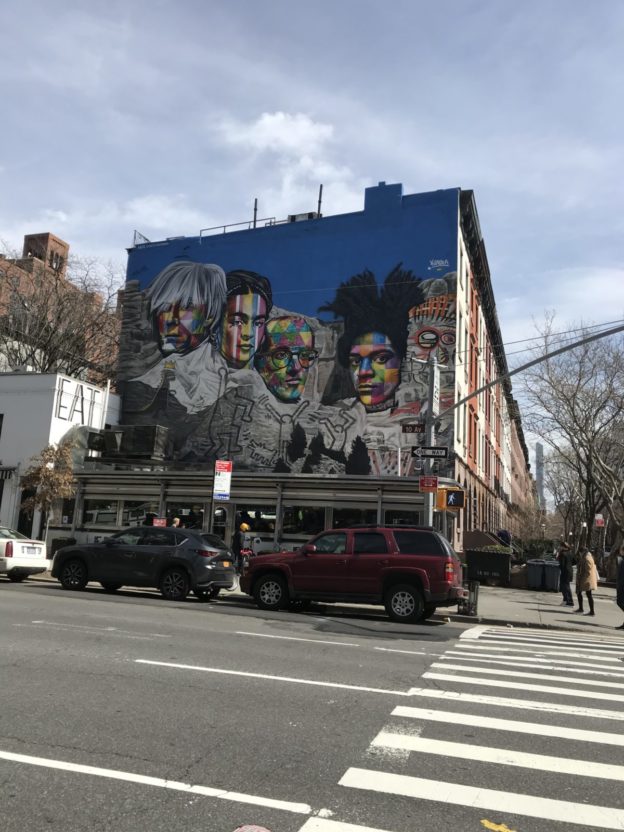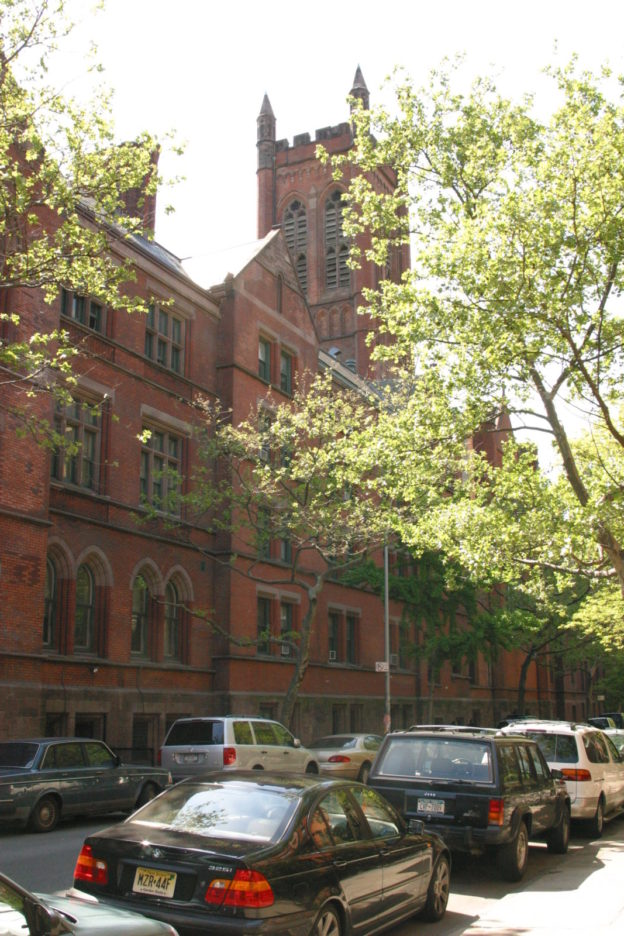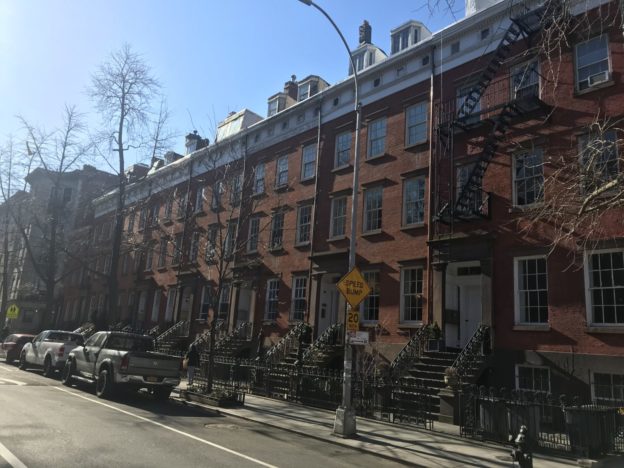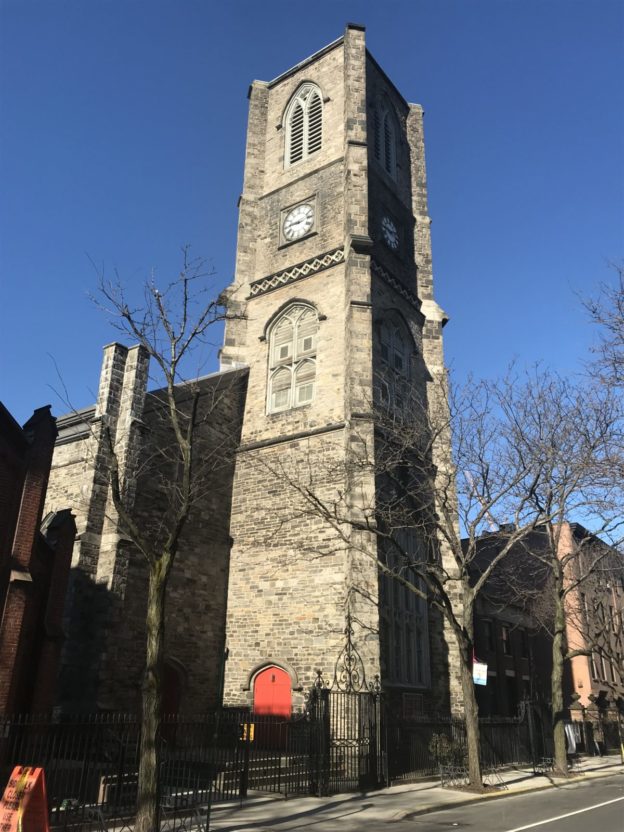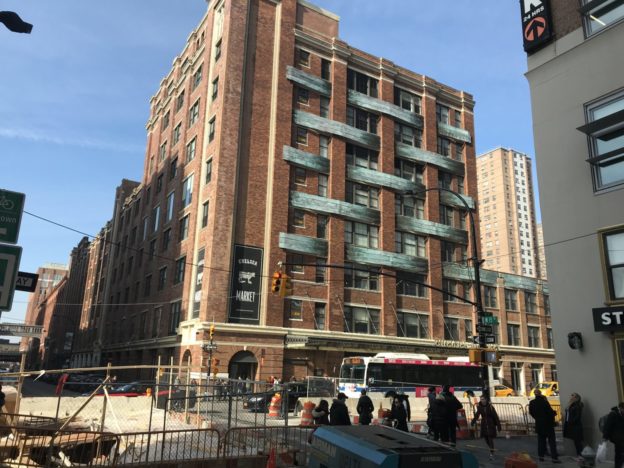601-625 West 26th Street
1930-31
Cory & Cory; Yasuo Matsui, associate; Purdy & Henderson, consulting engineers
The Starrett-Lehigh building was constructed in 1930-31 on the site of the Lehigh Valley Railroad rail yards. The massive concrete-framed structure occupied an entire city block and served as a freight terminal with rental warehouse and manufacturing space. Its influential design combines industrial and modernist sensibilities, incorporating functional elements like railroad tracks to receive trains directly into the building, freight elevators that conveyed entire trucks to upperfloor loading docks, and the curtain-wall technology that made possible the signature feature of unbroken ribbons of steel windows wrapping around the building. A pioneering work of architecture, it was one of only six American buildings featured in the Museum of Modern Art’s influential “International Style” exhibition in 1932. The curved forms and factory windows of many new buildings along the High Line reference this Chelsea icon. The Starrett-Lehigh Building is an Individual Landmark and located in the West Chelsea Historic District.
339 West 29th Street
1846-47
Inspired by the terraced houses of England, the north side of this block was developed as a continuous row of Greek Revival residences by William Torrey and Cyrus Mason, who gave it the vanity address Lamartine Place. It soon attracted a respectable group of homeowners including Abby Hopper Gibbons and James Sloan Gibbons, who purchased no. 339 in 1852. Well-regarded philanthropists and abolitionists, their house became a nexus for antislavery activity in pre-Civil War New York, and is the only documented stop on the Underground Railroad in Manhattan. During the Draft Riots of 1863, the Gibbons residence was targeted by a mob that set it afire. Family members fled across the roofs of the adjacent houses. The family later returned to their houses and made repairs. Though somewhat altered since, it is one of the few surviving sites directly associated with the Draft Riots. The Hopper-Gibbons House is house is located in the Lamartine Place Historic District
350 West 26th Street
1873; expanded and current facade 1907, Samuel Edson Gage
300 Ninth Avenue
1845-46, Minard Lafever; additions 1853-54, Lafever, and 1858, Charles Babcock of Richard Upjohn & Son
Lacking the restrictive covenants imposed by Clement Clarke Moore to the south, the blocks of Chelsea north of 24th Street, called Chelsea Manor, were developed with a mixture of residences, shops, and industry in close proximity. By the mid-19th century, it was a notorious center of vice and threat to vulnerable youth. In 1855, Sunday school advocate R.G. Pardee with help from the South Reformed Dutch Church, set up a mission above a disreputable saloon at Ninth Avenue and 25th Street. In 1866, the mission became an arm of the church, which built Manor Chapel and Mission, now Manor Community Church. Incorporating classrooms and a library, it was completed 1873. Enlarged and given a new façade in 1907, the building’s picturesque Dutch Revival style acknowledges its roots.
Two blocks north, the Church of the Holy Apostles is another of Chelsea’s historic Episcopal congregations, founded as a mission of Trinity Church. It has long had a socially active congregation and been called “one of the most important meeting places in New York City for organizations of the early post-Stonewall gay rights movement.” Architecturally, it is a remarkably original work that defies precise stylistic categorization. Italianate and Romanesque influences can be seen, but it forges a new statement from them. During the urban renewal era of the mid twentieth century, much of the area around it was officially labeled a slum and targeted for redevelopment. In the 1950’s, six entire blocks between Eighth and Ninth Avenues were condemned for the private, middle-income Penn South housing project. The developer agreed to save Holy Apostles, along with Manor Community Church and two other churches. Church of the Holy Apostles is an Individual Landmark and listed on the State and National Register of Historic Places.
1849-50
Philo V. Beebe, builder of nos. 437-459
The 12 houses from no. 437-459 were developed by Beverley Robinson (an associate of the Clarke/Moore family) and George F. Talman. Architecturally, these residences mark a transition between the upright, rectilinear Greek Revival and the more curvilinear Italianate styles. Though several of the houses have received updates in later architectural styles—seen especially in the cornices—the row remains unified by its deep front yards, paired stoops, and twin entrances. Immediately to the west stands the smaller, likely somewhat earlier residence at no. 461, which lacks the Landmark status of nos. 437-459. It is a purer example of Greek Revival architecture, with the style’s characteristic flush window lintels and a simple molded cornice from which tiny attic windows peek. The little house would originally have stood on the Hudson River bank. 437 to 459, and 461 West 24th Street are each Individual Landmarks and listed on the State and National Register of Historic Places.
West 23rd to West 24th Streets, Ninth to Tenth Avenues
1930-34
Farrar & Watmough
London Terrace Apartments comprises 14 connected 16- and 20-story buildings occupying the perimeter of an entire city block around two generous courtyards. Developed by Russian-born real estate magnate Henry Mandel, they were built in just two years at a cost of $6 million, included 1,670 units, and boasted an indoor pool, gymnasium, dining room, children’s play area, and roof terrace simulating the deck of an ocean liner, from which residents could see actual passenger ships docking at the Hudson River piers just blocks away. Of main appeal were the courtyards, a garden oasis in the middle of the city. Farrar & Watmough designed the buildings as a unified whole, enlivening the monolithic brick and terra-cotta facades with fanciful gargoyles and motifs from North Italian Romanesque, Gothic, and Renaissance architecture. “London Terrace” was borrowed from the row of 36 Greek Revival-style brownstone rowhouses demolished to make way for the new development. According to Mandel’s 1942 obituary, London Terrace “was hailed as the largest multifamily building unit in New York” at the time of its completion.
210 Tenth Avenue
1929 or 1943; altered 1976
Carl Laanes
The Empire Diner is a classic example of the streamlined, stainless-steel,
railroad dining car-cum- restaurant that modernized the urban tradition of horse-drawn lunch wagons catering mostly to working men. A diner, or “lunch wagon” (as it was labeled on a 1955 map of the neighborhood), was erected on this site in 1929, but may have been replaced with the present structure in 1943. In 1976, the diner received a makeover designed by Carl Laanes, the former head of MoMA’s graphics department. The Empire quickly became an important social gathering place for Chelsea’s gay community, and was instrumental in the “Chelsea Renaissance” of the late 1970’s and 80’s. Today one can still appreciate the vintage aesthetic of the diner’s shiny metal panels and contrasting black and white enameling.
440 West 21st Street
1827 and 1836; 1883-1902
Charles Coolidge Haight
The Seminary stands on land donated by Clement Clarke Moore, and originally included just the 1827 East Building, since demolished, and the matching 1836 West Building, which remains. Moore hoped the open campus would double as a value-enhancing town square, like Washington Square and Gramercy Park; it was in fact long called “Chelsea Square.” A seminary graduate, Eugene Augustus Hoffman, was installed as the first dean in 1879. Backed by his personal wealth, he began an ambitious building program known as the “Grand Design.” His architect Haight took inspiration from the Collegiate Gothic campuses of England and their quadrangles as well as the image of a medieval cloister. He built along three sides of the Seminary block’s perimeter, shielding its grounds from Ninth and Tenth Avenues and 21st Street, and preserving much of Moore’s original public-square intent. Left open on the south, Haight’s plan admitted sunlight and allowed the front gardens of the rowhouses across 20th Street—planned via a ten-foot setback laid out by Clement Clark Moore—to contribute their greenery to the leafy oasis of the Seminary. Haight’s design and the rowhouses opposite create a modern, urban version of an encircling cloister. The Seminary’s central, south-facing chapel occupies the traditional place of a medieval cloister church. Its bell tower, like St. Peter’s Church, is modeled on Magdalen Tower at Oxford. Despite unfortunate encroachments on the Seminary’s open space by luxury apartment construction, the block remains uniquely gracious and the heart of Chelsea. General Theological Seminary is located in the Chelsea Historic District and listed on the State and National Register of Historic Places.
404, and 406-418, West 20th Street
No. 404 West 20th Street has the distinction of being the oldest house in the Chelsea Historic District. It was built in 1829-30 for Hugh Walker on land leased from Clement Clarke Moore for forty dollars per year. The lease stated that if, during the first seven years, a good and substantial house of two stories or more was built of brick or stone, or having a brick or stone front, the lessor would pay the full value of the house at the end of the lease. Walker opted for the least expensive option, a two story house (to which a third story was later added) with a brick façade. The original wood of no. 404’s clapboard side wall can still be seen, facing the narrow side alley between it and no. 402 to the east. By 1835, Moore banned side alleys and wooden exteriors like no. 404’s altogether. They were a particular characteristic of early Chelsea. No. 404 is the last wooden house with a side passage left in Chelsea, a critical reminder of its humble, rustic origins. Standing where the oldest house’s wood clapboard side meets its brick front, one sees Chelsea turn the corner from semi-rural village to the sophisticated urban neighborhood so richly embodied in Cushman Row to its right.
The brick front of no. 404 served Moore’s purpose of raising his budding development’s profile and property value, the fruition of which is amply seen in the seven row houses that soon followed immediately west of it, at nos. 406-418. Known as Cushman Row, these were built in 1839-40 for developer Don Alonzo Cushman in the popular English mode of a single unified “terrace” of fashionable townhomes. Cushman Row presents a remarkably intact example of high-style Greek Revival architecture, rivaled in New York only by the famous row on the north side of Washington Square. Hallmarks of the Greek Revival style found here are smooth red brick facades with thin mortar joints, monumental brownstone door surrounds, front doors bordered by sidelights and transoms, ornate stoop and areaway ironwork featuring motifs such as palmettos and Greek keys, attic stories expressed as a monumental cornice entablature, and small decorative attic windows. 404, and 406-418, West 20th Street are located in the Chelsea Historic District and listed on the State and National Register of Historic Places.
336-346 West 20th Street
Rectory, 1831, attributed to Clement Clarke Moore;
Church, 1836-38, James W. Smith, builder
Worship services at the newly opened General Theological Seminary quickly became so popular that this independent congregation was established to serve the neighborhood’s booming population. The church complex is on land leased and later donated by Clement Clarke Moore, an active congregant who also supplied architectural sketches suggesting the design of the buildings. First completed was the chapel, now the Rectory, whose Greek Revival facade closely resembles Moore’s original vision. The Gothic Revival design of the church—called “the very first of the English parish Gothic churches built in this country” by the Landmarks Preservation Commission—was a marked departure from Moore’s design. It resembles Magdalen Tower, Oxford’s tallest structure, completed in 1509, supposedly as suggested by a vestryman who had visited there. The similarity would have been more pronounced before the deterioration and removal of St. Peter’s original wooden corner turrets, gone the way of its wooden porches. The Parish Hall is now a playhouse for the Atlantic Theater Company. Originally serving as the rectory, it was completed in 1871 and features a Victorian Gothic design. The oldest component of the complex is the iron fence, which dates to the 1790’s. It originally enclosed St. Peter’s Church downtown and was donated to the new congregation by Trinity Church. St. Peter’s Church is located in the Chelsea Historic District and listed on the State and National Register of Historic Places.
75 Ninth Avenue
Multiple architects, 1883 to 1934; Tenth Avenue frontage, 1932-34, Louis Wirsching, Jr.
This full-block complex, birthplace of the Oreo, was built in several phases over a number of decades. The oldest section was erected in the 1880’s for brewer Thomas McMullen. The rest of the block was developed in the following decades by the newly formed New York Biscuit Company. The baking industry experienced massive consolidation in the 1890’s, culminating in the merger of the New York firm with the American Biscuit and Manufacturing Company and the Chicago-based United State Baking Company in 1898. The resulting conglomerate, named the National Biscuit Company, officially established headquarters in its New York City complex in 1906. By 1920, the firm occupied all or parts of five city blocks on Manhattan’s west side. This location was perfectly suited for manufacturing purposes. A railroad spur was routed through the complex in 1904. When the High Line arrived in the 1930’s, the entire Tenth Avenue facade was redesigned to accommodate the elevated tracks. The company changed its name to Nabisco in 1941, and in 1956 divested its Chelsea factories during the deindustrialization of Manhattan. The building is an Individual Landmark and listed on the State and National Register of Historic Places.

